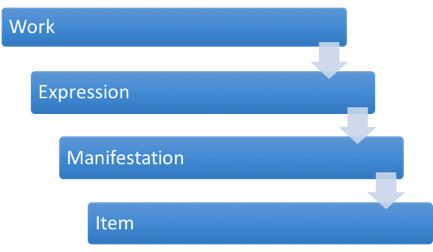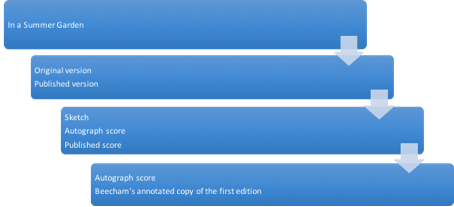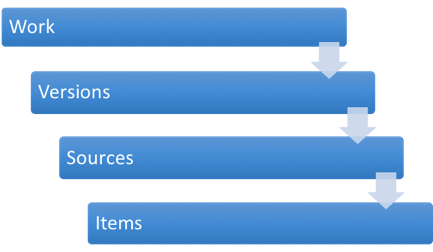Introduction
Table of Contents
Aims of the catalogue
The catalogue was created as part of the wider project ‘Delius, Modernism, and the Sound of Place’. This project pursued a new and comprehensive evaluation of Delius, testing the veracity of constructions of the composer as a nationalist and rhapsodic musical portraitist, investigating his compositional methods, and situating him within both different geographical contexts and the complex cultural phenomenon of modernism. Consequently, it was the aim of the catalogue to produce a resource that facilitated this investigation, that provided thorough and up-to-date information on the state of sources for a given work, its process of composition, editing, and revision, its performance history and its relationship to other works. At the same time, we wanted to create a practical resource of use to performers and general listeners. Thus, information such as publishing details, full instrumentation, and duration, as well as comprehensive search functions, have been incorporated.
Source materials
The vast majority of Delius’s manuscripts are now held by the British Library, being transferred from the Delius Trust in 1995. The collection comprises four sets of material: the manuscripts originally held by the Delius Trust, almost all coming from the Delius house at Grez-sur-Loing (British Library MS Mus. 1745/1); manuscripts passed to the Delius Trust from the Beecham Library (MS Mus. 1745/2); manuscripts passed to the Delius Trust by Boosey & Hawkes music publishers (MS Mus. 1745/3), and miscellaneous individual accessions (1745/4). The contents of the entire collection are described in the digital catalogue of the British Library, but it is important to note that this is not equivalent to a complete catalogue of works. Some manuscripts and material have been lost, and other items are held elsewhere. The Delius Trust retains a number of items not in Delius’s manuscript but of considerable interest in establishing the history of works, such as copies made of manuscripts and corrected by the composer, and a number of early editions owned by Sir Thomas Beecham and covered with his famous ‘blue pencil’ annotations. The Trust continues to acquire material that becomes available at auction. In addition, a small collection is held by the Percy Grainger Museum at the University of Melbourne, and other items are held elsewhere, notably the autograph score of Koanga in the Carl S. Swisher Library of Jacksonville University. Every effort has been made in the Delius Catalogue of Works to provide an up-to-date and comprehensive account of manuscript and other relevant sources.
Methodology
The creation of a digital catalogue raises a large number of methodological issues. While musical works are inherently ambiguous objects, a catalogue demands definite decisions as to the definition and dating of a work, and the ordering of the whole. There are problems common to any catalogue, such as those of numbering works, how much information to include, and how far to follow the practices of previous cataloguers. There are also issues distinct to the digital catalogue, and opportunities that do not present themselves in printed resources. Our primary points of reference throughout have been Robert Threlfall’s two catalogues, as a precedent for ordering the works of Delius, and the digital Catalogue of Carl Nielsen's Works (CNW) created using MerMEId. In general, we have been guided by aspects of both catalogues, but have deviated from their practices where appropriate.
Works, fragments, versions, arrangements, and collections
In this catalogue, a work has its own record and an individual DCW number. A given piece is defined as a work where it is coherent and complete work (even if, say, lacking complete orchestration) and it has some public presence, either in the form of publication or performance, though not necessarily both. Thus a number of works identified and numbered by Threlfall, for example Zanoni (RT I/1) or Légendes (Sagen) for piano and orchestra (RT VII/2), are not deemed works and have not been included here in the catalogue proper. Any identifiable piece of music that remains unfinished or fragmentary is listed in the Appendix.
Another area of ambiguity is where one work is included within another, or where a work comprises several versions, possibly with different titles. In the case of the former, where the original and/or later work have their own performance or publication history, they will each be denoted as an individual work. Mitternachtslied Zarathustras is therefore given a DCW number, because it was composed and performed as an independent work, before being incorporated into A Mass of Life. By contrast, La Ronde se déroule (RT VI/13) is the first version of the later Life’s Dance (VI/15), and is therefore incorporated into that DCW record.
The matter of arrangements is especially complex in the case of Delius, given that some arrangements – such as ‘La Calinda’ – are better known than the original work, and also given the large amount of arrangement undertaken by others at Delius’s behest or after his death. In this catalogue, on the whole, arrangements are listed within the DCW record only where Delius himself undertook the arrangement. Exceptions are where, for example, Delius engaged others to produce vocal scores of his operas shortly after composition, and thus the arrangement constitutes part of the preparation for performance or study rather than an independent creative output. Where the arrangement is a creative interpretation of Delius' original work undertaken with a new medium of performance in mind, it is listed in the Appendix. Thus, 'La Calinda', while well-known in its own right, is listed in the Appendix as an arrangement of material from Koanga by Eric Fenby. One ambivalent and exceptional category within these rules is those sources dictated by Delius to others, notably Fenby, when suffering from paralysis in his last years. In such cases, sources are included with the work record, and connoted by the term ‘authorize’ added to the title of a source.
A final problematic category is those works made up of parts, in which it is not clear whether the work is identical to the whole collection or to the constituent parts. The obvious example is song collections, but there are also confusing cases in Delius’s oeuvre like the Two Pieces for Small Orchestra (RT VI/19), made up of the miniatures ‘On Hearing the First Cuckoo in Spring’ and ‘Summer Night on the River’, each with its own performance and publication history. In the case of song collections, where a given work is a group of related, but independent songs (e.g. Five Songs from the Norwegian), each song is given an individual DCW number, while the collection is given a collection number (e.g. DCW Coll. 1). This renders searching and browsing easier, and allows the presentation of information common to the whole as well as that relevant only to an individual item. Where the work is an integral whole consisting of several songs, as for example in Songs of Sunset, they are not granted individual DCW numbers but are treated like movements. In addition to this treatment of songs, the method of attributing a ‘Coll.’ number has been adopted in the case of instrumental works that have a history both as a complete work and with regard to constituent items, as in the case of the Two Pieces or the 3 Symphonische Dichtungen.
Dating
Dating of works where it concerns a single point of completion is invariably difficult, especially in the case of works that underwent revision over several years. The date or date span given in each case reflects the period of composition. Where the work exists in several versions, an overall timespan is given from first to last version, and the dates of composition of each version are given in the course of describing them.
Numbering
The numbering system of the catalogue has been devised with two considerations in mind: i) optimal compatibility with MerMEId, which offers a specific ordering and categorisation of works by genre and ii) the avoidance of confusion with Threlfall’s ordering, given that his very first work, Zanoni , is relegated to the Appendix here. Bearing these factors in mind, works are numbered from DCW 1 onwards, by genre, as follows:
- Opera
- Incidental music
- Concerto
- Orchestral music
- Chamber music
- Keyboard music
- Works for voices and orchestra
- Works for solo voice and orchestra
- Works for unaccompanied voices
- Song
Within each category, works are ordered chronologically.
Names of people and works
A number of key players in Delius’s life had more than one name. Delius himself was Fritz until he adopted the anglicised name ‘Frederick’ in the course of 1902. His wife Jelka was Jelka Rosen before her marriage, and his friend Philip Heseltine is known by his compositional nom de plume Peter Warlock. In order to avoid confusion or difficulties in searching, we have referred to each such individual consistently, and have further used a mechanism in MerMEId to link each name to the VIAF authority files associated with the person. An exception is in the prose descriptions of letters and manuscripts and in citation, where original names and spellings have been preserved.
Titles of Delius’s works can occasionally prove problematic. Delius gave the same title to different works more than once (Paa Vidderne and Appalachia), while also frequently changing titles during composition or adding multiple ones in different languages to title pages. Here, the main title is always that which Delius himself chose as the final title of the finished work, as indicated by the autograph score, where that is extant. We eschew the practice of referring to the instrumental works just cited as On the Mountains and American Rhapsody respectively.
How to use the catalogue
Searching and browsing
The catalogue is fully searchable (full text) using the ‘Keywords’ box on the left-hand side of the page after clicking the ‘Catalogue’ tab. Users can also search for all works within a particular date range, or by genre, and order results by work (DCW) number, alphabetical title or date. Alternatively, by clicking on ‘Catalogue’, it is possible simply to browse through all the results.
Structure of each record
MerMEId was developed with reference to the hierarchical FRBR (Functional Requirements for Bibliographic Records) model. The model consists of four descending levels: Work, Expression, Manifestation, Item.

The work is an abstract entity, not equivalent to any physical item. Expression, in the case of a musical work, may consist of the composer’s notated music, or a performance of the work. Each version of the work, or performance, is a new expression. The manifestation level represents the physical embodiment of an expression of the work, such as the first edition of a musical work, or the recording of a particular performance. Item level denotes a single manifestation of an embodiment. This might, for example, include an author’s annotated personal copy of their published novel. Manuscripts are distinct in existing at manifestation and item level.
FRBR is used in a distinctive way within MerMEId, best illustrated by an example:

As this example demonstrates, the abstract entity In a Summer Garden has two expressions, its original and published versions. These in turn have several manifestations, known in MerMEId as sources, and there are, in turn, several items, invariably manuscripts already present at manifestation level or single, distinctive copies of printed items included at the manifestation level. Thus, to be summarise, in MerMEId FRBR is rendered thus:

Note that not included at this adapted model does away with performances at the Expression level. Where the work does not have multiple versions, performances are listed in their own section of a record, alongside sections containing other relevant information:
Work
- Music
- Sources
- Performances
- Documents/bibliography
In the event of multiple versions or other complicating factors, this hierarchy may be replicated at any level to incorporate information about, for example, performances of different versions:
Work
- Sources
- Preformances
- Original version
- Music
- Sources
- Items
- Performances
- Published version
- Music
- Sources
- Performances
- Documents/bibliography
Content of individual sections
The challenges of creating a complete catalogue within the timeframe of a year-long project necessitated many decisions regarding what information to include. Our decisions reflected the desire to include the most important information, while creating a structure into which further, more ephemeral details could incorporated later. Consequently, each record, with some exceptions, consists of the following:
Work titles are given, wherever possible, as inscribed by Delius on the autograph score. Translations in other languages and alternative titles and subtitles are included where they have been given.
Work numbers are provided. This includes not only the DCW number of a work but also the number in Threlfall’s catalogue and the relevant volume of the Collected Edition.
Information regarding others involved is provided, for example the name of a dedicatee, or at other levels, that of an arranger or editor.
Date of composition is provided, either as a single year or a span.
History : In most cases (except minor works where the sources are self-explanatory), a paragraph outlining the genesis and composition of the work is given, which may also include comments on sources, performance history, or titles.
Music : This section may include a variety of information, but will detail duration, instrumentation, and any subdivision of the work into sections or movements, and will provide one or more incipits.
Sources : Sources are listed in chronological order, as far as that can be determined, moving from sketches and drafts, to the autograph, to published scores. Individual items are attached to the sources they embody. Complete information (including number of folia etc) is not provided, but links to the British Library catalogue or other sources of more information are always given, and an overview of the nature and significance of each source will also be provided. This section also provides generic classificatory information about each source, namely whether it is music or text, print or manuscript, autograph or copy, its position in the compositional process (sketch, draft, fair copy, first edition etc), its scoring (full, short etc), and its level of completion. The terms within the latter classification have specific meanings in MerMEId. ‘Incomplete’ indicates the full work but with one or more parts missing; ‘Excerpt’ indicates that sections of the work have been intentionally omitted; ‘Fragment’ indicates that portions have been lost.
Performances : This catalogue currently includes only brief information about the date and place of a selection of early performances and those involved, without ephemeral information such as reviews.
Documents and bibliography : The catalogue gives references to letters published in the two-volume collection edited by Lionel Carley where these are important in determining the history of the work or are referred to directly in the history given. An exhaustive list of documents is not provided. For reasons of time, bibliography is also not provided except where a source has been referred to or where it is especially relevant to a record.
